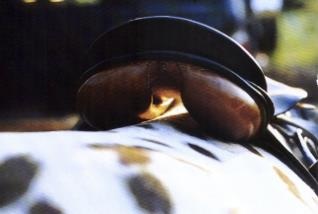How do I know if my saddle fits me and my horse?
A suitable saddle for horse and rider
As a rider, you undoubtedly have the comfort and well-being of your horse in mind. Horse-friendly riding starts with the choice of your saddle. After all, when riding, your saddle is literally the connection between you and your horse. It is therefore important that you are feeling comfortable in the saddle, but also that your saddle fits well on the back of your horse or pony.
Whatever saddle you choose, if it is not adapted to your horse, it will only cause problems. Make sure that your horse does not get backache or pressure spots by regularly checking your saddle and adjusting it if necessary.

How do you know if a saddle fits or not?
Very often the horse will show you. Here are some typical characteristics by which you can notice that something is probably not right (whether the saddle/girth is the cause of this will be determined by a later examination by a saddle specialist or a veterinarian):
- Difficulty with saddling (e.g. the horse is restless when you take the saddle off)
- Irritability and behavioural problems when being mounted (e.g. jumping away, hind leg kicking, biting the saddle,...)
- Thickened or swollen skin after riding (pressure spots or swelling under the saddle)
- White hairs on the withers or under the saddle
- Bald spots or curly or broken hairs under the cushions or at the rear of the saddle
- Dry patches under the saddle after riding (except over the spine)
- Restrained or impure gaits of the horse (e.g. unwillingness to gallop, no canter changes possible, lack of impetus, shortened strides, sloping gait, difficulty in changing hand, etc.)
- Unable to get the horse to collect itself (e.g. hollowing out the back while riding, head & neck position upwards, "falling apart"...)
- Stiff or painful muscles after riding (especially on the back and loins, sensitivity on the back when brushing, unusual posture when urinating ...)
- Problems with mounting (not standing still, bucking, dropping ...)
- Unmovable tail (as a result of tensing the back muscles for fear of pain - especially during jumping = non-movable tails!)

What requirements must a saddle satisfy?
Adapted to the horse's back (anatomy, conformation, musculature, growth)
- A means of communication between rider and horse (consistency between the rider's aids and those of the horse, comfort of the rider) or the importance of a correct seat
- Ensuring safety and not hindering either the horse or the rider (length, weight distribution, position of the saddle, freedom of movement and relaxation of the rider)
- Correct use in function of the construction of the saddle (right type of saddle in function of chosen discipline and rider, correct position on the horse's back).
In other words, the choice of a saddle will always be a correlation between the saddle (type/model, use & application), the horse's anatomy, the rider's anatomy (morphology, male/female), the horse's riding ability (age, level of training), the rider's riding ability.
Or... respecting the biomechanical, anatomical and physiological principles of both the rider and the horse!
Read more about this in our article on a suitable saddle.
Aleashop
BE0882.427.806


